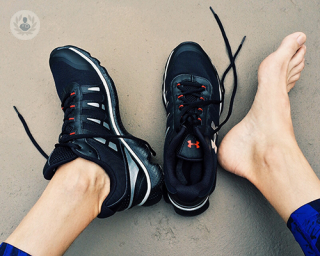What is ankle tendonitis?
Tendonitis involves an inflammation of the tendon. Ankle tendonitis, then, can simply be defined as an inflammation of the tendons of the ankle. Tendons attach the muscles to the bones in your body and help you to move, as well as acting as an important shock absorber.
Tendons can be injured in a number of ways. There are a number of tendons in the ankle including the toe and ankle extenders in the front, and the Achilles tendon and flexor of the big toe in the back.

Can ankle tendonitis be cured?
Most cases of tendonitis are resolved within a few weeks providing you give the injured tendon adequate rest. It is not common to need to seek further treatment after this time.
What are the symptoms?
The main symptoms associated with ankle tendonitis are:
- pain in the affected area
- difficulty with moving the ankle joint
- swelling
- a crackling sound when moving the joint
However, if you experienced a “pop” when you injured your ankle, you may have ruptured the tendon – in which case, it’s important to see a doctor right way.
What causes it?
Ankle tendonitis is often caused by overuse of the tendon. This can occur because you play a particular sport or your job involves manual labour. In other cases, tendonitis can occur as part of the ageing process, which makes them more prone to stress.
Can it be prevented?
You can help prevent ankle tendonitis by taking appropriate measures when you exercise, such as warming up beforehand and taking regular breaks.

How is ankle tendonitis diagnosed?
Ankle tendonitis can be diagnosed with a medical examination and the doctor asking about their symptoms. However, it is likely that you will not need to see a GP, as most cases of tendonitis can be treated at home.
If you see the GP because your symptoms haven’t improved after a few months, they may recommend further examinations such as an X-ray or MRI in order to investigate whether the pain is the result of a different condition.
How is ankle tendonitis treated?
You can usually treat tendonitis at home. For the first few days after the injury, try to rest it as much as possible, apply ice, and keep the ankle elevated. Afterwards, you should be able to start moving the joint. To reduce pain and swelling, you can visit your local pharmacy for painkillers and anti-inflammatory medication.
If the symptoms don’t improve after a few weeks, your doctor might recommend physical therapy, extracorporeal shockwave therapy, or steroid injections to tackle the inflammation. In severe cases, you may be offered surgery to repair the tendon.
What part of the ankle does tendonitis primarily affect?
Tendonitis tends to primarily affect the back of the ankle, but can also affect the inner part of the ankle, as well as the outside of the ankle joint.
What are the different types of ankle tendonitis?
There are many different kinds of ankle tendonitis. The most common ones include the following:
- Achilles tendonitis (affects the back of the ankle)
- posterior tibial tendonitis (inner ankle)
- peroneal tendonitis (the outside of the ankle joint)
- flexor tendonitis (inner ankle)
What type of doctor treats ankle tendonitis?
Sports medicine physicians and specialist orthopaedic surgeons treat ankle tendonitis.
11-13-2012 03-21-2017Ankle tendonitis
Mr Paul Hamilton - Orthopaedic surgery
Created on: 11-13-2012
Updated on: 03-21-2017
Edited by: Conor Lynch
What is ankle tendonitis?
Tendonitis involves an inflammation of the tendon. Ankle tendonitis, then, can simply be defined as an inflammation of the tendons of the ankle. Tendons attach the muscles to the bones in your body and help you to move, as well as acting as an important shock absorber.
Tendons can be injured in a number of ways. There are a number of tendons in the ankle including the toe and ankle extenders in the front, and the Achilles tendon and flexor of the big toe in the back.

Can ankle tendonitis be cured?
Most cases of tendonitis are resolved within a few weeks providing you give the injured tendon adequate rest. It is not common to need to seek further treatment after this time.
What are the symptoms?
The main symptoms associated with ankle tendonitis are:
- pain in the affected area
- difficulty with moving the ankle joint
- swelling
- a crackling sound when moving the joint
However, if you experienced a “pop” when you injured your ankle, you may have ruptured the tendon – in which case, it’s important to see a doctor right way.
What causes it?
Ankle tendonitis is often caused by overuse of the tendon. This can occur because you play a particular sport or your job involves manual labour. In other cases, tendonitis can occur as part of the ageing process, which makes them more prone to stress.
Can it be prevented?
You can help prevent ankle tendonitis by taking appropriate measures when you exercise, such as warming up beforehand and taking regular breaks.

How is ankle tendonitis diagnosed?
Ankle tendonitis can be diagnosed with a medical examination and the doctor asking about their symptoms. However, it is likely that you will not need to see a GP, as most cases of tendonitis can be treated at home.
If you see the GP because your symptoms haven’t improved after a few months, they may recommend further examinations such as an X-ray or MRI in order to investigate whether the pain is the result of a different condition.
How is ankle tendonitis treated?
You can usually treat tendonitis at home. For the first few days after the injury, try to rest it as much as possible, apply ice, and keep the ankle elevated. Afterwards, you should be able to start moving the joint. To reduce pain and swelling, you can visit your local pharmacy for painkillers and anti-inflammatory medication.
If the symptoms don’t improve after a few weeks, your doctor might recommend physical therapy, extracorporeal shockwave therapy, or steroid injections to tackle the inflammation. In severe cases, you may be offered surgery to repair the tendon.
What part of the ankle does tendonitis primarily affect?
Tendonitis tends to primarily affect the back of the ankle, but can also affect the inner part of the ankle, as well as the outside of the ankle joint.
What are the different types of ankle tendonitis?
There are many different kinds of ankle tendonitis. The most common ones include the following:
- Achilles tendonitis (affects the back of the ankle)
- posterior tibial tendonitis (inner ankle)
- peroneal tendonitis (the outside of the ankle joint)
- flexor tendonitis (inner ankle)
What type of doctor treats ankle tendonitis?
Sports medicine physicians and specialist orthopaedic surgeons treat ankle tendonitis.


How long does it take to recover from ankle tendonitis?
By Mr Matthew Solan
2024-12-15
Problems with the tendons in the foot and ankle can take a while to recover from, but what can you do to help this process? Leading consultant orthopaedic surgeon, Mr Matthew Solan explains all. See more


Ankle pain – getting the diagnosis right.
By Mr Paul Hamilton
2024-12-14
Have you ever suffered from foot and ankle pain? Learn more about the causes of ankle pain, including ankle sprains and Achilles tendon tears. See more


Deal with your heel! A guide to how heel pain can be treated
By Mr Paul Hamilton
2024-12-14
Top orthpaedic surgeon Mr Paul Hamilton ends his series of articles on heel pain with a guide to treatment See more


Deal with your heel! A guide to how heel pain can be treated
By Mr Paul Hamilton
2024-12-14
Top orthpaedic surgeon Mr Paul Hamilton ends his series of articles on heel pain with a guide to treatment See more
Experts in Ankle tendonitis
-
Mr Turab Syed
Orthopaedic surgeryExpert in:
- Ankle tendonitis
- Hip replacement
- Foot and ankle
- Sports injuries
- Cartilage repair
- Knee replacement
-
Mr Haroon Majeed
Orthopaedic surgeryExpert in:
- Ankle tendonitis
- Ankle
- Achilles tendon
- Foot fracture
- Inflammatory arthritis
- Plantar fasciitis
-
Mr Mark Bowen Davies
Orthopaedic surgeryExpert in:
- Foot and ankle
- Osteoarthritis of the ankle
- Arthritis
- Ankle arthroscopy
- Ankle tendonitis
- Traumatic injury
-
Mr Jonathan Larholt
PodiatryExpert in:
- Foot arthrodesis
- Ankle tendonitis
- Bunion (hallux valgus)
- Toe pain
- Hammer toe
- Plantar fasciitis
-
Mr Nicholas Masucci
PodiatryExpert in:
- Foot arthrodesis
- Ankle tendonitis
- Bunion (hallux valgus)
- Hammer toe
- Toe pain
- Sports podiatry
- See all

Kings Park Hospital - part of Circle Health Group
Kings Park Hospital - part of Circle Health Group
Polmaise Road Stirling FK7 9JH
No existe teléfono en el centro.
By using the telephone number provided by TOP DOCTORS, you automatically agree to let us use your phone number for statistical and commercial purposes. For further information, read our Privacy Policy
Top Doctors

The Wilmslow Hospital - part of HCA Healthcare
The Wilmslow Hospital - part of HCA Healthcare
52-54 Alderley Road, Wilmslow, Cheshire, SK9 1NY
No existe teléfono en el centro.
By using the telephone number provided by TOP DOCTORS, you automatically agree to let us use your phone number for statistical and commercial purposes. For further information, read our Privacy Policy
Top Doctors

OSOM Care
OSOM Care
Manor Lodge, Mill Lane
No existe teléfono en el centro.
By using the telephone number provided by TOP DOCTORS, you automatically agree to let us use your phone number for statistical and commercial purposes. For further information, read our Privacy Policy
Top Doctors
-
Kings Park Hospital - part of Circle Health Group
Polmaise Road Stirling FK7 9JH, StirlingExpert in:
- Vascular Surgery
- Cardiology
- Colorectal surgery
- General Surgery
- Neurological spinal surgery
- Plastic surgery, reconstructive and aesthetics
-
The Wilmslow Hospital - part of HCA Healthcare
52-54 Alderley Road, Wilmslow, Cheshire, SK9 1NY, WilmslowExpert in:
- Breast Cancer
- Men's health check
- Orthopaedic surgery
- Obstetrics and Gynaecology
- Women’s health
- Sports Medicine
-
OSOM Care
Manor Lodge, Mill Lane, CheadleExpert in:
- Arthritis
- Hip
- Pain management
- Shoulder and elbow
- Hand and wrist
- Sports Medicine
- See all
- Most viewed diseases, medical tests, and treatments
- Ulnar nerve entrapment
- Peripheral nerve block
- Peripheral neuropathy
- Joint pain
- Lumbar herniated disc
- Spinal surgery
- Minimal access surgery (keyhole surgery)
- Shoulder pain
- Osteoporosis
- Anxiety








